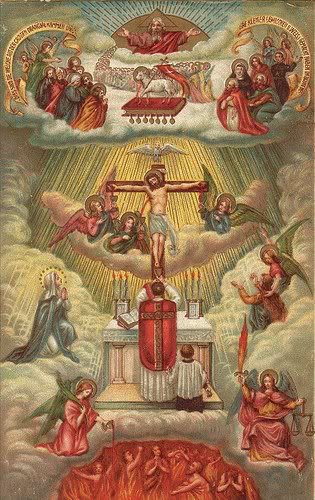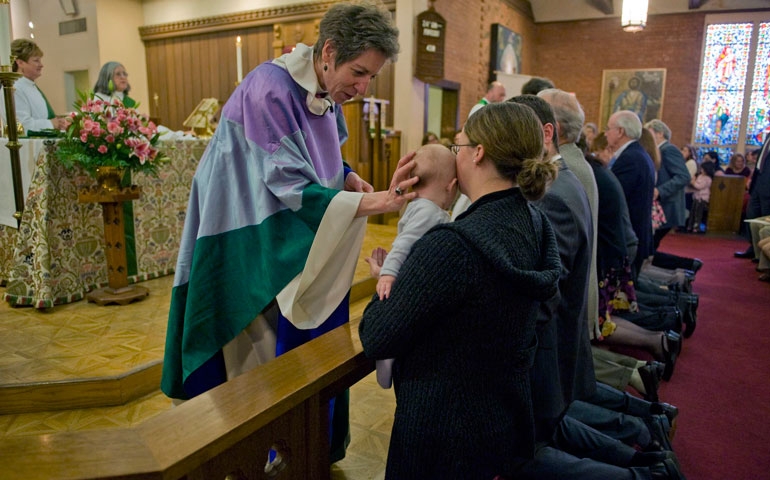 Preliminary comments. Priests are for sacrifice. Sacrifice requires priesthood. If you don’t have sacrifice, you don’t need priests. You can have ministers, instead. Ministers are fine, but they aren’t priests.
Preliminary comments. Priests are for sacrifice. Sacrifice requires priesthood. If you don’t have sacrifice, you don’t need priests. You can have ministers, instead. Ministers are fine, but they aren’t priests.
Second, Anglicans/Episcopalians don’t have priests because they don’t have valid orders. No, they don’t.
Moreover, do Anglican even want to have sacrifice? Isn’t their “Mass”, their “Eucharist”, a memorial of Christ’s Sacrifice, merely? Catholics believe that Mass is an objective Sacrifice, the renewal of the once-for-all time event, rather than its mere commemoration. We had this fight in the 16th century.
They reject the notion of objective sacrifice, an understand of Mass as the unbloody renewal of Christ’s bloody Sacrifice on Calvary as propitiation for our sins. Mass can also be seen as “banquet”, but it is, first and foremost and inextricably Sacrifice.
It seems to me that these women – catholic priest-wannabes too – want to be ordained to the clergy, rather than to the priesthood. They don’t really want to be ordained to the priesthood, properly understood, because – say it with me – priests are principally for … sacrifice. A priest who rejects sacrifice is like a potter who condemns clay, a butcher who nixes knives, a fireman who flees fires. Priesthood detached from sacrifice is an absurdity.
Lastly, even if Episcopalians did have valid orders, women couldn’t receive them. No, they can’t.
 Now, I direct your attention to Fishwrap (aka, at least today, the National Episcopalian Reporter) which is celebrating 40 years of Episcopalian women being “ordained” (not) to their “priesthood” (not). The piece as all the right words and phrases: “informal barriers to advancement” … “irregular ordinations” … “brave women deacons and a handful of risk-taking bishops”. It’s a hoot.
Now, I direct your attention to Fishwrap (aka, at least today, the National Episcopalian Reporter) which is celebrating 40 years of Episcopalian women being “ordained” (not) to their “priesthood” (not). The piece as all the right words and phrases: “informal barriers to advancement” … “irregular ordinations” … “brave women deacons and a handful of risk-taking bishops”. It’s a hoot.
Watch especially for the strange use of “ordain”. Ask yourself along the way: “Ordain … to what, exactly?” To ministry, perhaps. There is complete confusion about the concept of “ministry” and “priesthood”. These are NOT the same concept. They article was, by the way, written by a Presbyterian, so this confusion isn’t really a surprise. But let’s admit it: lots of Catholics are confused about priesthood and ministry.
As you read, ask yourself another question: “Why do liberals pretend that women can’t do anything valuable if they don’t say Mass? Are women who give their lives in service to the Church simply losers because they don’t say Mass?” What are we to make of make of this condescending attitude? For example, from the article: “Would I be the energetic Episcopal church lady that my mother had been, content with teaching Sunday school and organizing the food pantry? Or would I have left the church altogether? I don’t really know.” My emphasis.
By the way, note how Fishwrap exalts Episcopalian “Bishop” Katharine Jefferts Schori. They splash a big photo of her.
Is this the same Katherine Jefferts Schori who, as “bishop” in Nevada hired a former Benedictine monk from Collegeville knowing that he was a pedophile? Yes, I believe she is the same. HERE
Have the editors of Fishwrap howled for her chitlins as they have for Bp. Finn’s or Archbp. Nienstedt’s? She did something worse than those real bishops are alleged to have done.
No, she get’s a pass from the Fishwrap. And she is exalted by them. Why is that?



































Even with all the pervasive heresy in the Episcopalian Organization, some of them still keep the orthopraxis of kneeling at the rail for receipt of whatever it is they are receiving. Is the use of that particular photo the fishwrap’s way of trying to tweak folks who pray for a return of proper reverence for the Holy Sacrifice of the Mass?
This weekend I am heading over to the baseball field down the street to be ordained a starting pitcher for the New York Yankees.
Gregg,
The only tweaking of which the Fishwrappers are capable is that of their arthritic joints.
As our priest said in a recent sermon at EF Mass,
“If there’s no sacrifice, then it’s no Mass, and the celebrant is no priest, because he’s a priest only if he offers sacrifice.”
But father, but father! They have altar rails!
It is a shame that in that picture they’re generally better dressed than most at the NO mass as well as before their symbolic imitation of the Eucharist. A shame the women don’t have covered heads, but that’s a mixed bag.
The subject reminds me of a discussion with someone about the Minor Orders recently and noted how tonsured clerics, distinct from Major Orders, did many/most of the tasks that we now have well meaning pious & well meaning “church ladies” in the parishes offices doing but that SHOULD arguably be done by tonsured clerics without pulling our priests and deacons from their respective ministries.
Simply winding the clock back to the era between Trent and Vatican II wouldn’t bring back the way things were. Pope Leo XIII already saw the decrease in the clergy (“whose labors in the vineyard of the sacred ministry are now increased owing to the diminution in the number of laborers.”) well before WWI caused the “suicide of Europe” (per Benedict XV), much less Vatican II. Pope Paul VI saw error in the minor orders being obsolete solely as seminary markers but should have instead of suppressing them (contradicting Trent’s Session 23, canon 2), called instead for their renewal in the diocese & parish.
Yet, which bishops or pastors dare to offend these devoted mothers, who wouldn’t find raising boys and supporting their brothers, sons, and even husbands in such roles rewarding enough? The extension to Anglican & Episcopalian heresy seems obvious…
I’m trying to wrap my mind around the picture of the people kneeling at an altar rail. If they do not have a true Eucharistic consecration, what are they doing??
I envy my Methodist and Episcopalian relatives the possibility of kneeling at an altar rail to receive whatever they understand Communion as being. I don’t understand why Catholics have been denied this privilege when even some of our Protestant brethren still understand the longing for reverence.
I have been taught that a twofold “problem” exists in that picture:
1. the altar rail causes people to feel excluded from the worship of God by means of being a physical barrier between the people and the altar & priest (the priest being no better than anyone else), and
2. kneeling like a penitent causes a person to feel bad when really they should be standing around the table of the Lord as the joyful people of God (the priest being no better than anyone else).
So I try to figure out why only the priest uses the table if gathering around it for a common meal is the primary point of it all. I haven’t figured it out yet.
And now I see this picture, presented as if the altar rail and kneeling are okay anyway.
Which would not be a problem if not for the fact that I like to know when I am supposed to be protesting as a matter of important principle and when I am supposed to be protesting simply because protesting is what we are supposed to do. Maybe the altar rail and kneeling protests are “just because” protests?
Strange photo. What is this, the Episcopalians have become the first all-female church?
Poor little trendy things. On their way to extinction, altar rails or no.
There are those in the Anglican world who believe in the True Presence of Christ in the Eucharist. For quite a number of years before I left the Episcopal Church to become Roman Catholic, I was among them, as was my wife. And the foregoing was the case in spite of Article XXVIII of the Thirty-Nine Articles of Religion, which trace back (if I am not mistaken) to Thomas Cranmer, the first Protestant Archbishop of Canterbury under Henry VIII. That Article, entitled Of the Lord’s Supper, reads as follows:
Fortunately for me, I had not read Article XXVIII, and so was sufficiently Catholic in my beliefs before I found it morally intolerable to remain in the Episcopal Church, and thus found transubstantiation no obstacle to becoming Catholic.
Pax et bonum,
Keith Töpfer
There is also, Keith, Article XXIX:
XXIX. Of the Wicked, which eat not the Body of Christ in the use of the Lord’s Supper.
The Wicked, and such as be void of a lively faith, although they do carnally and visibly press with their teeth (as Saint Augustine saith) the Sacrament of the Body and Blood of Christ; yet in no wise are they partakers of Christ: but rather, to their condemnation, do eat and drink the sign or Sacrament of so great a thing.
When the 39 Articles were formulated in 1562, Queen Elizabeth vetoed Article XXIX, so from 1562 to 1571, when she signed an Act of Parliament giving statutory authority to all 39, there were only 38 Articles. Article XXIX was aimed as much against classical Lutheran views about the presence of Christ’s Body and blood “in, with, and under” (to use the Lutheran phrase) the elements of bread and wine, as against Catholic teaching, and the queen was very reluctant to alienate Lutheran princes throughout her reign, and especially in its early years. One Church of England bishop, Richard Cheyney of Gloucester (d. 1579) – the patron of St. Edmund Campion in his Anglican years, and a kind of “Erasmian” in his theological views (he served as a Catholic priest in England during the reign of Mary Tudor) was actually excommunicated by Archbishop Parker of Canterbury (d. 1575) for refusing to accept Article XXIX, and it appears that the queen forced Parker to lift the excommunication without requiring Cheyney to subscribe to it.
Weren’t there two anglicans studying in Rome at a time who, after the validity of their orders, were nicknamed “null” and “void”?
In that vein, if they sent a woman ‘bishop’ along with them, I suggest we change it to “null, void and vacuum”
Last week I was visited by a good friend of mine who I had been patiently evangelizing. He attended Mass with me, and ‘enjoyed it’. It’s a good start.
Anyway, so our conversation turned to ordination of wymym and he recounted a recent experience of having been invited to the ‘christening’ of a mutual friend’s baby, at an Anglican church, officiated by a ‘vicar’ and ‘deacon’, both women. Both were also quite obviously lesbian and in a relationship, while their behavior towards each other on emerging from the sacristy suggested they had been doing a little more than getting attired. He was pretty disgusted at the whole affair, and his lack of participation in the ceremony as a result garnered looks of disdain from said wymyn, which he admitted gave him a sense of satisfaction: “yes, I am disgusted at you both, and I’m glad you can see it” to paraphrase his words to the effect thereof. He went, he said, in order to ‘support his friend’, with the result that he was once and for all put off by this sham sacramental (emphasis on mental!) display, and lost a lot of respect for said friend in the process.
He is in my prayers constantly.
I have been praying that my parents find their way. My Mother was a devout Roman Catholic until she met my Father, an Episcopalian. I can count on one hand the amount of times I went to church as a child. Lately, my Mother has been going through adversity and I can tell she wants to go back badly. My Father has been down on the Episcopal Church for decades due to the whole wymnpriest thing, but he also makes excuses for not going to the Catholic Church on a regular basis. It just so happens that they have an Anglican Ordinariate near them. I shared some of Father Z’s posts around the Ordinariate with my Father. I may have convinced him to go and take my Mother so they can start meeting their obligations, and help a fledgling community. Pray for them please.
The Eucharist is a memorial. The sacraments are signs (cf St Aug & Thomas), and a memorial is a sign. . . . in mei memoriam feceritis.
This Memorial, however, does not merely produce a psychological association. The double consecration not only reminds us of the separation of Christ’s Body from His Blood, it also has an ontological relationship to what it signifies
It is a sign of the passion and death of Christ ( not the Last Supper) as the cause of sanctification, the sign of the form of sanctification (grace and the virtues), and the sign of the end of sanctification (eternal life). And so we can have an idea what St Augustine means by memory of the future.
Phil, your joke reminds me of certain formulations of set theory where the successor function of the empty set, S(?) = 0. (Some authors refer to the symbol ‘?’ as ‘void’).
Argh, that post worked on preview:
S(∅) = 0
∅ named ‘void’.
Well, that would be a rather space-oriented set theory, then. The successor (in any meaningful dimensional sense) of the empty linear space {} (which is not usually defined but easily can be) is the null linear space K^0 = {0}. The next successor would then be K^1 = K, and so on.
Standard set theory, though, is surprisingly intuitive: Though we all learned in school to accurately distingish {} and 0, they are defined as “at bottom” identical, so null and void are the same thing, and its successor is 1 of course ( := {0}, but that’s another story).
Imrahil, thanks for that.
Von Neumann’s generative approach, iirc. Long time now, with a lot of philo of maths in between. Also, a definite shortcut in my post.
For those who support women “priests” it has never been about theology. It matters not to them about sacrifice or ministry, it is all about power. Who controls the purse strings, property and power. This is quite evident in the moves of the Episcopal Church in the U.S. against parishes and diocese seeking to break from them. They care no a whit for the people and ministers that they are loosing and everything about the property they will lose control of.
This is the same reason dissident sisters cling to the Catholic Church. It is not only that they become uninteresting to the media if they formally break with the Church, but also if they can maintain an official position with a legitimate church organization they can be placed in a position which allows them to skim funds, spend money donated by the faithful for other purposes, and generally not have to get a real job. For this group the holy grail is to wait out every other member of your failing order and then sign over all the assets to yourself just before quitting, leaving a hollow shell while you live in luxury the rest of your life off the assets provided to generations of faithful laity. There’s even a couple of ex-nuns who will walk you through the process, to ensure the mean ol’ Vatican can’t stop your legalize theft of assets.
Pingback: Flannery O’Connor, Fifty Years After - BigPulpit.com
Uxixu says:
Simply winding the clock back to the era between Trent and Vatican II wouldn’t bring back the way things were. Pope Leo XIII already saw the decrease in the clergy (“whose labors in the vineyard of the sacred ministry are now increased owing to the diminution in the number of laborers.”) well before WWI caused the “suicide of Europe” (per Benedict XV), much less Vatican II. Pope Paul VI saw error in the minor orders being obsolete solely as seminary markers but should have instead of suppressing them (contradicting Trent’s Session 23, canon 2), called instead for their renewal in the diocese & parish.
Sorry for the delay.
1. The drop off in vocations was mostly in the diocesan priesthood (Ireland was an exception). In fact, the religious orders were flourishing up to the time of Vat II (in 1964 the US SJ’s had about 4000 scholastics and 500 novices). The orders offered the opportunity for a more intense spiritual life and a more thorough intellectual formation, which made it more attractive to a laity with more years of education. In places like the US it was common for religious orders to run parishes, so the thinking was that it was possible to have the best of both worlds.
2. A few things must be kept in mind when considering the minor orders. a. Before Trent there were no seminaries. The education of priests usually took place in parishes–which explains any parochial existence of minor orders and sub diaconate. b. The minor orders had a function in the Cathedral Schools (Abeland was in minor orders when he met Heloise) and in religious houses with a community mass.
3. IMHO, Ministeria Quaedam was directed at parishes, and that is its flaw.